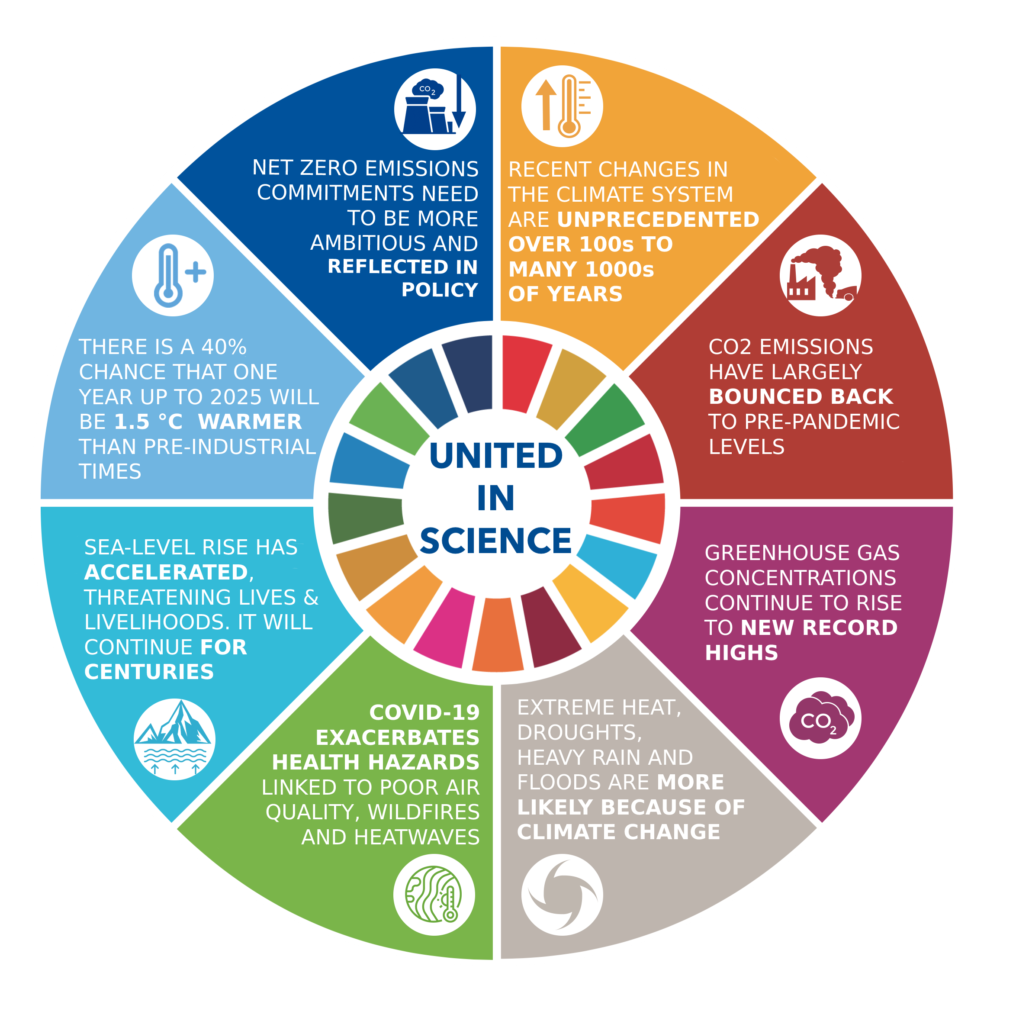By Yves Guérard, FCIA
The release from the Actuaries Climate Index (ACI) by the CIA and other US actuarial associations is the last one before signatories of the Paris Agreement meet in Glasgow this November. It shows that after repetitive increases, the average for the last five years is now 1.19 points above the reference period of 1961–1990. What is more statistically significant is that the upward trend, despite minor fluctuations reflecting inherent climate variability, shows a continuing increase in the frequency and intensity of extreme weather events. According to climatologists, this increase is due to global warming caused by the accumulation of greenhouse gas (GHG) emissions.
Countries’ targets for GHG emissions reductions fall short of the agreed goal
Under the Paris Agreement, countries are required to establish nationally determined contributions (NDCs) to reduce global GHGs in order to “limit global warming to well below 2, preferably to 1.5 degrees Celsius, compared to pre-industrial levels” and to update them every five years, as may be necessary. The upward trend of the ACI confirms reports by other sources like the NOAA and Keeling Curve that signatories would need to upgrade their NDC commitments at the first quinquennial update, originally scheduled for 2020. A score of recent forest fires, floods, and heat waves around the world also add a sense of urgency. However, COVID-19 delayed the UN Climate Change Conference of the Parties (COP 26). Thus 2021 is the first test of the signatories’ resolve to correct the course of events. The decision to turn down sponsorship from big polluters, whereas previous COP were sponsored by the fossil fuel industry, can be seen as a positive signal.
The UNFCCC published a synthesis report of the latest NDCs submitted by the 191 Paris Agreement signatories up to July 30, 2021. It includes Canada’s NDC, but 78 others still have to be updated. The NDCs aggregate projections, including conditional commitments, show emissions may peak between 2025 and 2030 and put us on track to an estimated end-of-century temperature increase of 2.7 (2.1–3.5) °C, with expected serious consequences.
The synthesis report reminds the parties that, as per the Intergovernmental Panel on Climate Change (IPCC) special report of 2018, “to be consistent with global emission pathways with no or limited overshoot of the 1.5 °C goal, global net anthropogenic CO2 emissions need to decline by about 45 per cent from the 2010 level by 2030, reaching net zero around 2050. To limit global warming to below 2 °C, CO2 emissions need to decrease by about 25 per cent from the 2010 level by 2030 and reach net zero around 2070.”
Speaking at the opening of the 76th UN General Assembly on September 21, Secretary General Antonio Guterres sounded an alert: “Five weeks away from COP 26, many countries are not aligned with these objectives.”
September has seen a flurry of climate-related activities linked to the UN General Assembly. Of particular importance is the publication of “United in Science 2021: A multi-organization high-level compilation of the latest climate science information,” which regroups data actuaries may need to manage climate risks.
Closing the wide gap between pledges and objectives
The gap from 1.5 °C to 2.7 °C means a wide range of uncertainty to model by actuaries in climate scenario analysis. It adds uncertainty to estimates of stranded assets, impacting investments and bank financing as well as actuarial assumptions for matching discounted values of assets and liabilities and enhancing sustainability.
This wide gap also calls for difficult decisions at COP 26. A positive side of the delay to 2021 is that lessons have now been learned from the COVID-19 pandemic. These lessons can influence the outcomes of COP 26 by making science-based decisions more acceptable. In my opinion, key lessons include the following:
- Both decision makers and civil society need to be mobilized.
- Messages need to be consistent to prevent confusion and hesitancy.
- Misinformation has major negative impacts.
- Voluntary compliance alone will likely fall short of achieving the objectives.
Nature has collaborated by demonstrating in real time what can be some physical impacts of global warming. But whereas experience from the pandemic emerges on a time scale measured in weeks or months, climate outcomes materialize on a time scale measured in years or decades, making accountability and attribution more difficult. It suggests that longer-term strategic planning must be complemented by shorter-term actions to ensure delivery. Indeed, progress has been made, with global warming being projected to year 2050 rather than the end of the century and more attention paid to the credibility of the path. Promises of reducing emissions by 2050 are complemented by shorter-term milestones like 2030.
Transparency is needed to prevent misinformation and neutralize false information already circulating. Many actuarial associations offer free public access to reliable sources, such as the CIA’s climate resources page providing links to information and data on global warming, mitigation, adaptation, and other climate-related issues. The actuarial profession has the credibility necessary to promote the acceptance of reliable information and enlighten discussions of climate issues within civil society.
“In a pandemic, one person’s actions affect the well-being of others. And whenever there are such externalities, the well-being of society requires collective action: regulations to restrict socially harmful behavior and to promote socially beneficial behavior.”
Joseph E. Stiglitz, former chief economist of the World Bank
The experience of actuaries in using long-term scenarios to find optimal fact-based solutions resting on sound actuarial principles can be expanded beyond our traditional practice areas to help decision-makers compare climate policy options. The fourth lesson learned above suggests that the voluntary approach should be complemented by strong incentives. Actuaries should not shy away from harnessing their creativity and working with other professionals to help develop actionable policy options and efficient incentives to move forward with decarbonization.
This quote by renowned Nobel laureate in economics and former chief economist of the World Bank, Joseph E. Stiglitz, applies to the pandemic but can just as easily apply to climate issues: “In a pandemic, one person’s actions affect the well-being of others. And whenever there are such externalities, the well-being of society requires collective action: regulations to restrict socially harmful behavior and to promote socially beneficial behavior.”
Finding the proper balance in managing the pandemic continues to be a difficult challenge for countries, but similar questions must be addressed to achieve a consensus on global climate objectives.
COP 26 decisions and the way they are implemented may impact actuarial work
- Although the Paris Agreement original target was “below 2 °C,” the current consensus has shifted to the aspirational target of 1.5 °C. The impact of this 0.5 °C was laid out in an IPCC special report in 2018. Given that global warming has now passed the 1.2 °C mark and CO2 concentration peaked at 415.26 ppm in May 2019, more entities, from G7 leaders to over 100 national governments and thousands of non-state actors, have committed to the 1.5 °C target and to the UN Race to Zero net emissions by 2050.
- Compliance with the 2017 recommendations of the Task Force on Climate-related Financial Disclosures (TCFD) is voluntary, but the G7 and many other bodies are pushing to make TCFD reporting mandatory and include one common scenario, for example a path limiting warming to 1.8 °C in 2050. Actuaries can provide a model by drawing from the reporting of pension expenses on a common basis despite differences in actual financing paths and, working with other professionals, help provide adequate guidance. This would facilitate enforcement of environmental, social, and governance investing principles.
- While countries’ NDCs are voluntary and not legally enforceable, COP 26 may add binding riders made more acceptable to all countries by leveling the playing field, such as mandating a minimum carbon tax, setting a firm deadline for decommissioning coal fired power plants or phasing out the sale of cars emitting GHGs, with tangible trade consequences for countries not meeting the requirements.
- The shift to a green economy requires global coordination to achieve an orderly transition to new infrastructures and continuity in access to energy, food, and water. Financing being the key, the United Nations have appointed Mark Carney as a Special Envoy for Climate Action and Finance. In his opinion, the global market for trading carbon offsets may reach US$ 50 billion by 2030, resulting eventually in transfers of up to US$ 100 billion per year from developed countries mainly to developing countries since these are the more likely sources for the offsets. Financial impacts may be significant.
- COP 26 may provide a forum to debate the allocation of financing to the extraction of rare metals and between competing technologies critical to manage the intermittency of energy generation, from solar panels, wind turbines, and hydrogen cells, to ammonia (NH3) as a fuel substitute for existing internal combustion engines (including the auxiliary motor in hybrid cars). In my opinion carbon capture and storage (CCS), other than natural proven sinks like forests, entails high and non necessary risks, except as a supplement to decarbonization, to mitigate a temporary overshoot of the level targeted for GHG emissions.
Actuaries can help extend the Paris Agreement to adaptation and resilience
In the broadest sense, the original agreement focused on mitigation, whereas we are now moving into a world that needs to pay urgent attention to resilience and adaptation as suggested in a recent UN news release.
As global citizens and professionals, actuaries need to give some priority to a climate-sensitive, sustainable future and help enhance collective financial and societal well-being. As we did in the past, we can contribute to improved climate policy decisions in Canada. Individually, nationally through the CIA, and globally through the International Actuarial Association. 75,000+ actuaries can help improve global policy decisions. Every bit helps! COP 26 signatories drive political decisions, but the details at implementation level is what will matter for actuaries, so they should be prepared to participate in the formulation of clear, consistent, and financially sound proposals for the management of climate financial risks.
At this critical moment, I feel compelled to respond to the call to action on climate risks as framed in Time to Act a statement issued by the CIA in September 2019, asking myself, “What constructive role can I play?” I was further motivated by the persuasive wake-up call of the Secretary General to world leaders at the 76th UN General Assembly: “It’s time to ring the alarm bell. We are on the verge of a precipice and we are moving in the wrong direction.”
By 2050, it will not matter for me if the net zero is reached or not, but the youngest of my four grandchildren will be turning 43. What about yours?
Yves Guérard, FCIA, FSA, Hon. FIA, PhD(hc), retired in 1999 but has remained active on the international scene. From 1997 to 2010 he was Secretary General of the International Actuarial Association and since August 2019, member of its Climate Risk Task Force. He is a member of the CIA Climate Change and Sustainability Committee and represents Canada on the Actuaries Climate Index Working Group. From 1984 to 1990 he served on the Economic Council of Canada and on the Panel of Senior Advisors to the Auditor General of Canada from 1997 to 2015.



